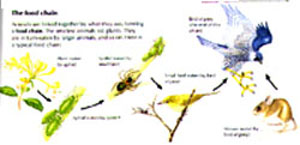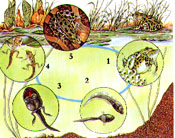Animal Life and Food Chains

|
Far left: Plant (eaten by aphid)--> Aphid eaten by the spider-->
Spider (eaten by small bird)--> Small bird (eaten by bird of prey)-->
Mouse (eaten by bird of prey) Bird of prey (the end of this chain)

|
Frogs lay their eggs in water (1) which hatch out into
tadpoles (2). The tadpoles slowly change into adults
(3 and 4), then come out of water to breathe air and live
on land (5)
Frogs belong to the species of amphibians.
Frogs have smooth skins and are usually smaller and
slimmer than toads. Webbed toes and strong back legs
make frogs good swimmers. Frogs can breathe through
their skin, as well as through their lungs.
Amphibians
Amphibians can live both in water and on land . They are
cold-blooded, which means that their body temperature is
the same as their surroundings. Many amphibians begin
life as tiny, fish-like tadpoles, which live in water and breathe
through gills. As they grow, their bodies slowly change. By
the time they are adults, they are able to live on land and
breathe through their lungs. The 4,000 or so species of
amphibians are divided into three groups - frogs and toads,
newts and salamanders, and caecilians.
|
|
|
|
Top |